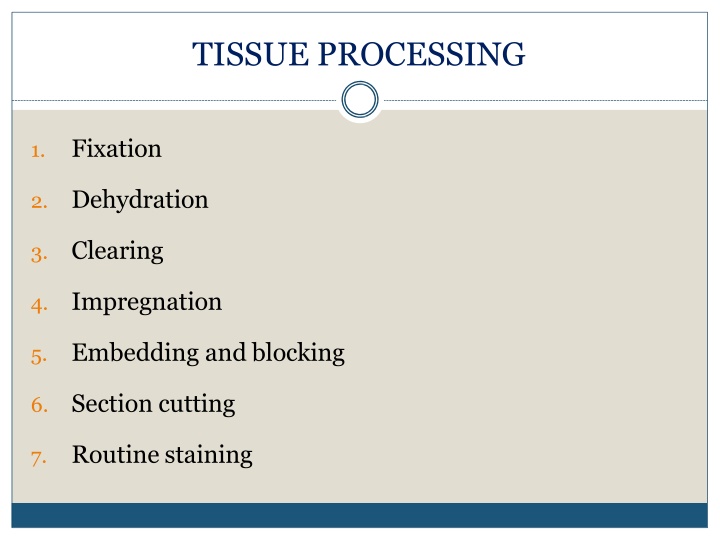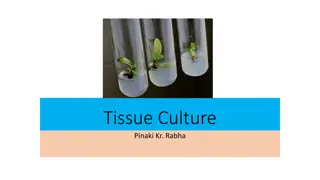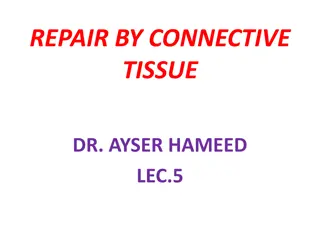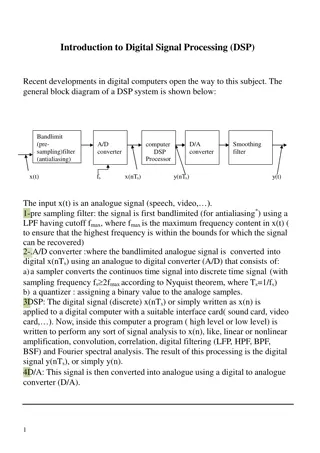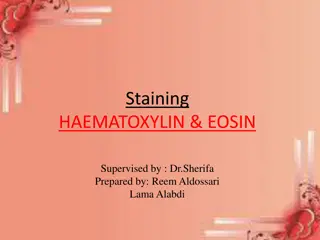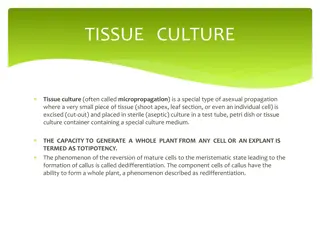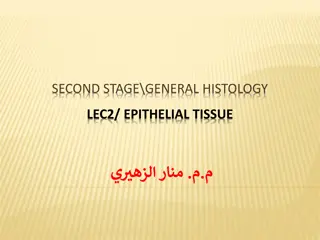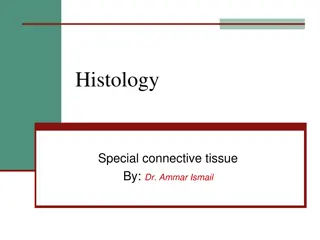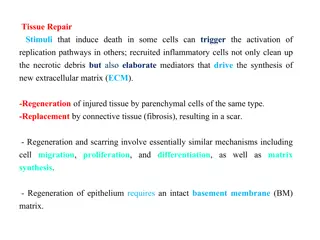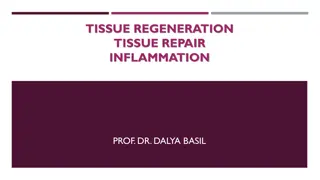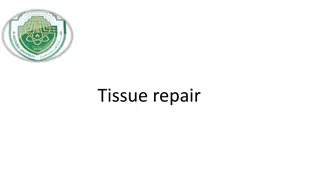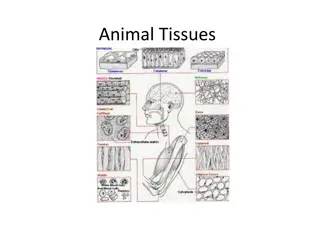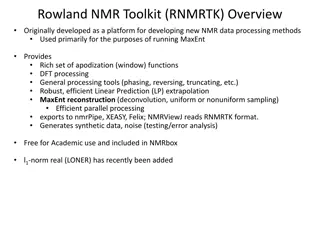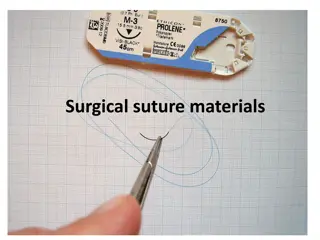Tissue Processing and Common Fixatives Overview
In tissue processing, the steps include fixation, dehydration, clearing, impregnation, embedding, section cutting, and routine staining. Common fixatives like Formalin, Glutaraldehyde, and Picric acid are used for different tissues. Understand the pathophysiology of the endocrine system and pituitary disorders such as growth hormone deficiency and excess of growth hormone in children and adults. Explore thyroid disorders like goiter and their complications.
Download Presentation

Please find below an Image/Link to download the presentation.
The content on the website is provided AS IS for your information and personal use only. It may not be sold, licensed, or shared on other websites without obtaining consent from the author.If you encounter any issues during the download, it is possible that the publisher has removed the file from their server.
You are allowed to download the files provided on this website for personal or commercial use, subject to the condition that they are used lawfully. All files are the property of their respective owners.
The content on the website is provided AS IS for your information and personal use only. It may not be sold, licensed, or shared on other websites without obtaining consent from the author.
E N D
Presentation Transcript
TISSUE PROCESSING Fixation 1. Dehydration 2. Clearing 3. Impregnation 4. Embedding and blocking 5. Section cutting 6. Routine staining 7.
COMMONLY USED FIXATIVES Formalin MC routine Glutaraldehyde electron microscopy Picric acid(Bouin s solution) renal & testicular tissue Alcohol(Carnoy s fixative) cytologic smears, endometrial sampling Osmium tetraoxide CNS tissues & electron microscopy
Pathophysiology of Endocrine System Dr.Athmar mohamed
Pituitary disorders Causes : tumor hemorrhage trauma irradiation
Pituitary disorders Growth hormone deficiency children - short stature (pituitary dwarfism), normal intelligence, obesity adults - central obesity, reduced muscle mass and exercise capacity. (pituitary dwarfism),
Pituitary disorders Excess of GH in childhood Pituitary gigantism growth velocity proportional enlargement of skeleton and inner organs enlargement of the peripheral nerves delayed puberty and hypogonadism Pituitary gigantism
Pituitary disorders Excess of GH in adults Acromegaly reason somatotrope adenoma hyperplasia and hypertrophy of soft tissues size of hands, feet, nose, ears cartilaginous proliferation of the larynx coarsening of the facial features. enlarged tongue and increase of inner organs thick and dark skin. degenerative arthritis. Acromegaly
Thyroid disorders Goiter Goiter - size of the thyroid gland (not related of TH level) Complications of goiter: difficulty in swallowing, distention of the veins of the neck and upper extremities, edema of the eyelids and conjunctiva, syncope with coughing. .
Thyroid disorders Congenital hypothyroidism - cretinism Causes congenital absence of the thyroid gland abnormal biosynthesis of thyroid hormone deficient TSH secretion. Clinics: mental retardation, impaired growth.
Thyroid disorders Acquired hypothyroidism myxedema accumulation of a mucopolysaccharide substance in the connective tissues. Causes destruction or dysfunction of the thyroid gland, impaired pituitary function hypothalamic dysfunction.
Disorders of gall bladder By Dr.Athmar mohamed
2 main types of gall stones : Cholesterol stones Pigment stones In the West, about 90% are cholesterol stones. Pigment gall stone is predominant in non- Western population associated with bacterial infection of biliary tree and parasitic infestations.
Pigment stone Bilirubin calcium salt is predominant Pigment stones Black pigment , hemolytic anemia (hemoglobinopathy, red cell disorders) Brown pigment Asian patients (infection) Cholesterol stone Content : Crystalline cholesterol monohydrate is predominant
Pathology Pigment stones Cholesterol stones : : Black stone (in sterile gall bladder bile)- small size, fragile to touch, numerous, 50-70% are radioopaque Brown stone (in infected intrahepatic or extrahepatic ducts)- single to a few, soft, greasy, soaplike consistency due to presence of retained fatty acids released by bacterial phospholipases on biliary lecithins, radiolucent. Stone content : calcium salts of unconjugated bilirubin, lesser amounts of other calcium salts, mucin glycoproteins and cholesterol. Gross : pale yellow, ovoid, firm, single to multiple with faceted surfaces Mostly radiolucent, 20% is radio opaque due to the presence of calcium carbonate content.
Complications : Inflammation of gall bladder (cholecystitis) Empyema Perforation, Fistulas
Complications-cont Inflammation of biliary tree (cholangitis) Obstructive cholestasis Pancreatitis Erode adjacent bowel and cause intestinal obstruction (gallstone ileus)
Pathology of acute cholecystitis Gross : Enlarged, tense, edematous, red or violaceous colour (subserosal haemorrhage) Fibrinous /fibrinopurulent exudate covering the serosa +- stones obstructing the neck or cystic duct Lumen contains blood and pus (empyema) Green black necrotic Microscopic : acute inflammation in the wall mucosal ulceration. May be associated with abscess formation or gangrenous necrosis.
Clinical features : recurrent attacks of epigastric or right upper quadrant pain Nausea, vomiting and intolerance to fatty foods. Pathology: Gross : smooth and glistening to dull serosa (subserosal fibrosis) thickened wall, opaque gray-white appearance Uncomplicated cases, lumen contains clear, green, mucoid bile and stones with normal mucosa
Microscopic : Reactive proliferation of mucosa Inflammation (lymphocytes, plasma cells, and macrophages in the mucosa and in the subserosal fibrous tissue). May be minimal.
Prominent outpouching of the mucosal epithelium through the wall (Rokitansky Aschoff sinuses) Marked subepithelial and subserosal fibrosis +-Superimposed acute inflammation +-Extensive calcification within the wall porcelain gall bladder increase risk of cancer
Xanthogranulomatous cholecystitis: massively thickened wall with shrunken, nodular, chronically inflamed with foci of necrosis and haemorrhage. Hydrops of the gall bladder : atrophic, chronically obstructed gall bladder containing only clear secretion
Complications of cholecystitis Bacterial superinfection with cholangitis or sepsis Gall bladder perforation and local abscess formation Gall bladder rupture with diffuse peritonitis Biliary enteric (cholecystenteric) fistula, with drainage of bile into adjacent organs, entry of air and bacteria into biliary tree and potentially gallstone-induced intestinal obstruction (ileus) Aggravating of preexisting medical illness, with cardiac, pulmonary, renal or liver decompensation Porcelain gall bladder with increased risk of cancer
